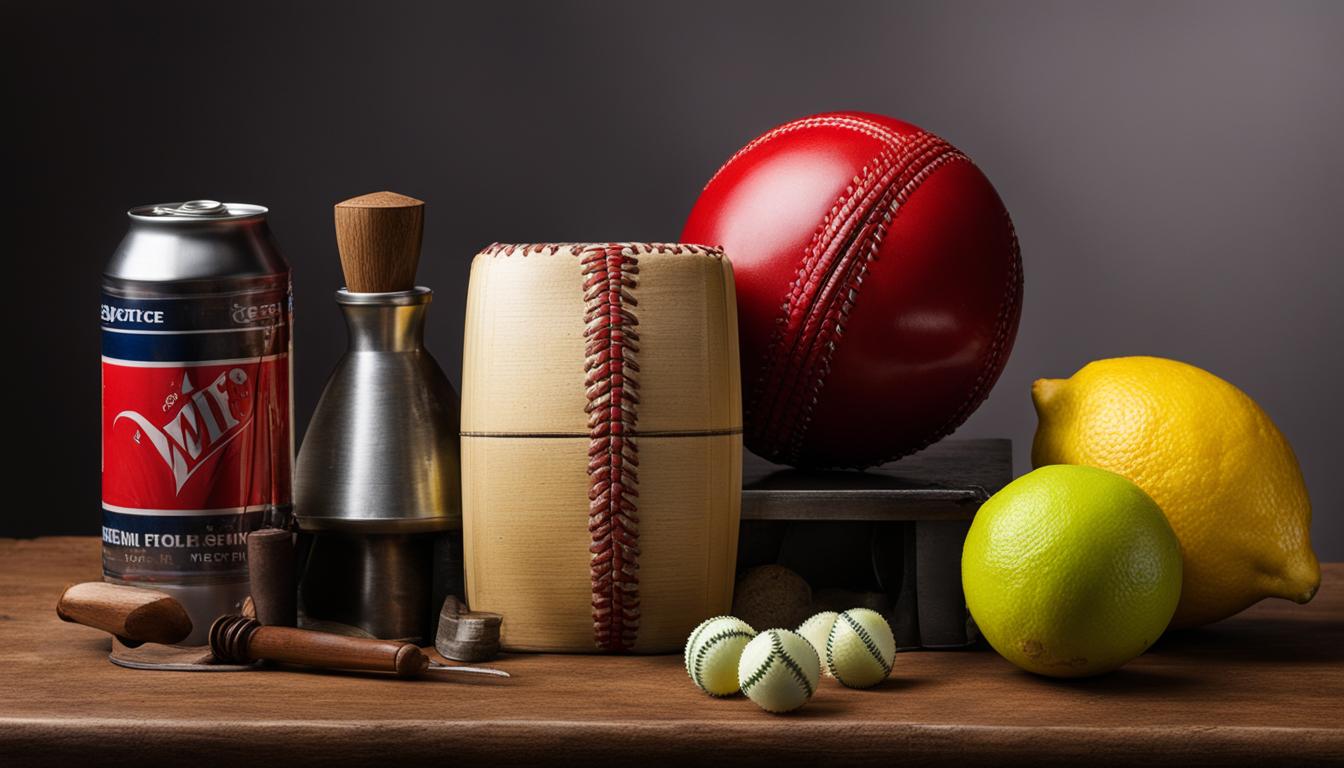As someone deeply invested in the intricacies of cricket, I often find myself engrossed in the details that define the game—and cricket ball weight is a cornerstone of such details. How heavy is a cricket ball, I’ve learned, is not just a trivial fact; it’s pivotal to understanding cricket sport details and the overall dynamics of gameplay. It affects everything from a player’s interaction with the ball to its trajectory and speed, making cricket ball specifications an essential element for anyone connected to this classic sport for how heavy is a cricket ball.
Key Takeaways
- The weight of a cricket ball is central to the sport’s integrity and player performance.
- Understanding cricket ball specifications helps in appreciating the game’s complexities.
- Cricket ball weight contributes significantly to its behavior and gameplay trajectory.
- Knowledge of cricket sport details like ball weight enhances the spectator experience.
- Consistency in cricket ball weight ensures fair and predictable matches.
Exploring the Fundamentals: A Cricket Ball’s Standard Weight
As I delve deeper into the core elements of cricket, understanding the cricket ball standard weight is critical for players, manufacturers, and aficionados. The official cricket ball is a product of stringent cricket equipment regulations that ensure a uniform experience across the sport’s competitive spectrum. This harmonization of cricket ball specifications is a testament to the sport’s commitment to fairness and integrity.
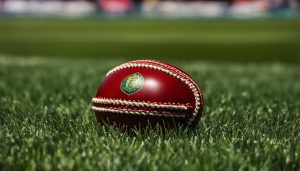
The official weight range of a cricket ball is not merely a number; it is a reflection of the game’s rich tradition and evolving craftsmanship. This regulation aids in the consistent performance of balls, impacting everything from bowling speed to batting technique, and is crucial for maintaining the sport’s classic allure.
The adherence to the regulated weight standards of cricket balls not only levels the playing field but also challenges the skill and strategy of the athletes. Let’s take a closer look at these regulations and the accepted weight standards that define an official cricket ball:
| Cricket Ball Component | Standard Specification | Regulatory Body |
|---|---|---|
| Weight | 155.9 grams to 163 grams | International Cricket Council (ICC) |
| Circumference | 22.4 cm to 22.9 cm | International Cricket Council (ICC) |
| Material | Leather with a cork core | International Cricket Council (ICC) |
Abiding by these established guidelines is non-negotiable for manufacturers, resulting in products that athletes can trust for training and match situations alike. Beyond the weight, other attributes like the ball’s circumference, material composition, and quality play an equally significant role in aligning with the cricket equipment regulations.
To sum it up, the cricket ball standard weight is a cornerstone of the game, upholding the essence of cricket and enabling a fair, competitive environment where talent truly shines through.
The Impact of Material and Design on Cricket Ball Weight
The performance and characteristics of a cricket ball in high-performance sports equipment are heavily influenced by its design and the materials used in its manufacture. At the heart of a cricket ball’s craftsmanship lies the intricate balance between its two primary components – the leather covering and the cork core.
Leather and Cork: The Core Constituents
In my experience, the unique combination of a durable leather exterior and a robust cork core is essential for a cricket ball’s endurance and overall dynamics. The leather cricket ball is made of a high-quality hide that is meticulously treated to provide a surface that is not only hard-wearing but also offers the grip required for bowlers to execute their diverse range of deliveries. Sitting at the center of this leather shell is the cork core, fundamental in lending the cricket ball its weight and bounce, a factor that dramatically influences the game on the field.
A Fusion of Durability and Performance
The vision behind the crafting of cricket balls is to create a piece of equipment that can sustain numerous overs in any cricket match. As a result, the durability of the ball is paramount. The leather must be processed to resist the wear and tear of high-velocity impacts, while the cork core must be dense and resilient. Crafting a cricket ball is not just about withstanding pressure but also about maintaining optimal performance from start to finish.
The Art of Crafting a Standard Cricket Ball
This artistry is steeped in tradition yet continues to embrace innovation within sports equipment manufacturing. With precision, I select only the highest grade of leather and layer the cork to achieve the precise weight required for a cricket ball. The stitching and application of lacquer are done with great attentiveness to detail, ensuring that when the cricket ball takes the spotlight in the pitch, it embodies the perfect fusion of aesthetic appeal and functional excellence.
| Cricket Ball Component | Material Quality | Function | Impact on Game |
|---|---|---|---|
| Exterior Leather | Premium-grade, treated | Durability and Grip | Resistance to wear and spin control |
| Cork Core | Dense, resilient | Weight and Bounce | Ball dynamics for bowling and batting |
| Stitching | Precision craftsmanship | Integrity and Aesthetics | Seam condition affecting ball swing |
| Lacquer Finish | High-quality application | Seam protection and Shine | Improved aerodynamics and visual appeal |
How Heavy Is a Cricket Ball?
As I delve into the world of professional cricket sports gear, understanding the cricket ball weight range is pivotal. A standard cricket ball, which plays a significant role in the game’s dynamics, boasts precise cricket ball specifications. The weight of these balls significantly affects their balance and aerodynamics. In professional games, these specifications are not just minor details; they’re essential for the integrity of the sport.
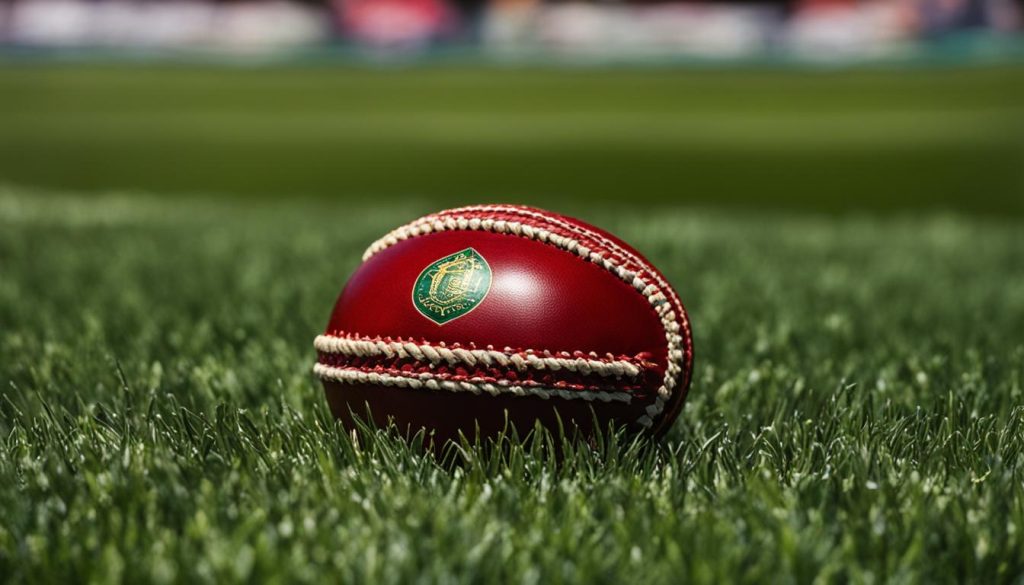
The weight of a cricket ball is stipulated to be within the range of 155.9 grams to 163 grams. This range accounts for minute, permissible variations to ensure that the ball remains suitable for professional play, even after extended use. Thus, in my coverage of professional cricket sports gear, acknowledging the importance of these weight specifications is necessary.
The precise weight allows bowlers to employ a plethora of techniques, from expert spin to seam, with remarkable control. A ball’s journey from bowler to batsman is influenced greatly by its weight, dictating the play’s pace, spin, and subsequently, the excitement of the game.
- Weight Range: 155.9g to 163g
- Importance: Key to balance and aerodynamics
- Effect on Gameplay: Influences bowler’s delivery and batsman’s response
My examination confirms the harmonious interplay between a cricket ball’s weight and player performance. It’s the blend of well-defined cricket ball specifications and high-quality crafting that distinguishes professional cricket sports gear, making each match a showcase of skill enabled by meticulously designed equipment.
Comparing Cricket Ball Variants: Training versus Professional Balls
In the diverse world of cricket, the variety of balls used for different levels of play is astounding. From professional matches to training sessions, the choice of the ball can greatly impact a player’s experience and performance. Below, we delve into the characteristics and designs of popular cricket ball variants tailored for various stages of cricketing practice and play.
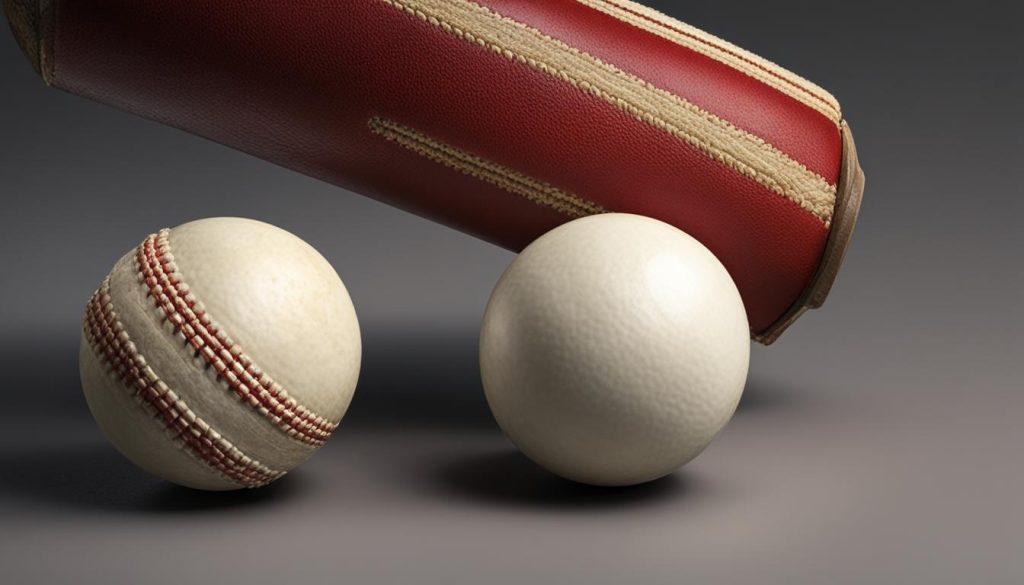
Nivia Heavy Weight Cricket Tennis Ball Characteristics
My focus on the Nivia cricket tennis ball delves into its unique attributes, garnered to bridge the gap between a training cricket ball and its professional counterpart. Ideal for novices, this heavy-weight option offers a consistent performance, earning its spot as a staple in beginner cricket equipment. Its tangible heft mimics the feel of a professional ball, enhancing muscle memory and technique in budding cricketers.
Features and Design Specifics of Flash Men’s Synthetic Cricket Ball
The Flash synthetic cricket ball is an innovative addition to synthetic sports gear. Notable for its standout orange hue, this ball weighs in at a mid-range 90 – 95 grams. What sets it apart is its rubber-molded stitching, a testament to inventive cricket ball design, and its synthetic makeup that ensures resilience under all playing conditions.
Assessing the Cosco Light Weight Cricket Ball for Practice
The Cosco cricket ball redefines lightweight cricket equipment with its design intended for effortless play. High bounce and a fluorescent color for optimal visibility culminate in an ingeniously designed practice ball. This variant proves to be incredibly accessible, providing a hassle-free experience for players across all skill levels.
| Ball Type | Weight | Material | Design Feature | User Level |
|---|---|---|---|---|
| Nivia Heavy Weight Cricket Tennis Ball | Heavy | Rubber, Tennis ball felt | Shock-reducing core | Beginner to Intermediate |
| Flash Men’s Synthetic Cricket Ball | 90 – 95 grams | Synthetic, Rubber-molded stitching | Water-resistant | All Levels |
| Cosco Light Weight Cricket Ball | Lightweight | Synthetic | High bounce, Fluorescent color | All Levels |
Diving Deep into the Manufacturing Process
The artistry behind crafting a cricket ball is grounded in centuries-old traditions of sports equipment craftsmanship. Anchored by meticulous attention to detail, cricket ball manufacturing integrates time-honored techniques with contemporary innovations to deliver a product that meets and exceeds the demands of premium sports gear production. My exploration begins with selecting the finest leather, chosen for its durability and grain quality.
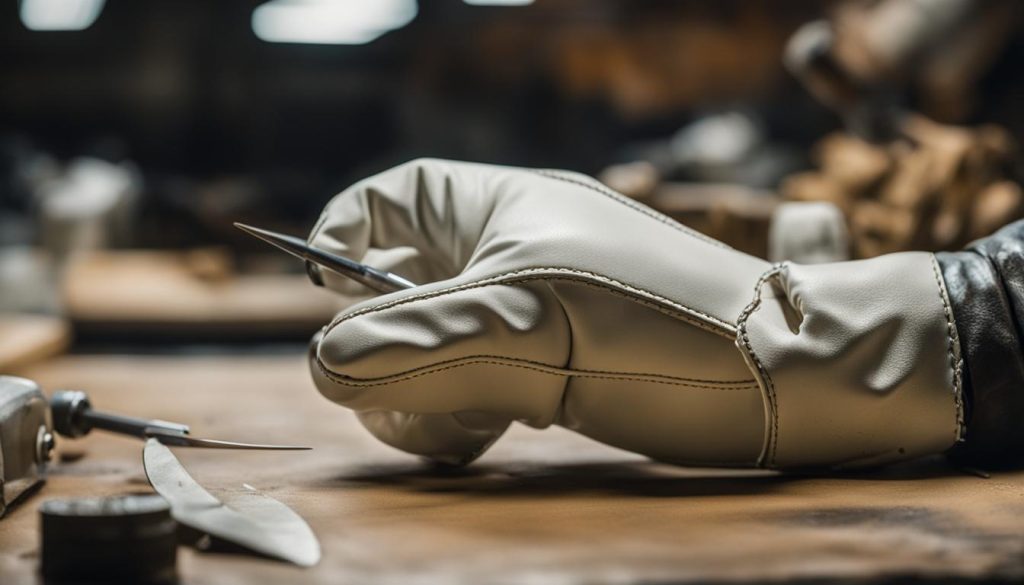
Shaping the Cork Core:
The journey starts with the core. Precision is key, as the cork is weighed and shaped, ensuring the perfect balance and mass required for professional gameplay. This essential element provides the foundation upon which all subsequent layers depend.
Crafting the Leather Cover:
Once the cork core is defined, high-quality leather is cut into four quarters. Each piece is then intricately stitched together, enveloping the core. This step is crucial in determining the final aerodynamic properties and overall performance of the cricket ball.
Final Touches:
The almost-complete cricket ball then undergoes a transformation with the application of vibrant dyes, followed by a layer of protective lacquer. Every stitch is reinforced, and the seam is sealed, culminating in a polished finish that signals the ball’s readiness for the pitch.
- Rigorous Quality Control: To uphold the strict standards of professional cricket, each ball is examined meticulously. Everything from the weight to the seam integrity is scrutinized to ensure consistent play.
- Matchday Preparation: The balls are conditioned to match the specific requirements of the gaming environment they will encounter, whether it’s a humid afternoon or a cool evening under stadium lights.
As someone deeply invested in the world of cricket, witnessing the transformation of raw materials into a dynamic piece of sports equipment instills in me an appreciation for every pitch, catch, and boundary made possible by this intricate manufacturing process.
In the Field: The Cricket Ball’s Journey Through the Game
As a cricket enthusiast, I recognize that every match unfolds a unique narrative, one that’s largely written by the trajectory of the cricket ball. Once cradled in the bowler’s firm grip, it embarks on a precise path shaped by its weight, which marries physics with artistry each time it’s hurled towards the batsman. My experience has taught me that the standard weight of a cricket ball is not merely about complying with regulations—it’s about crafting a contest where skill and strategy are paramount.
From the Bowler’s Hand to the Boundary:
Watching a cricket ball’s flight from bowler’s delivery to the boundary is to witness a blend of force, spin, and aerodynamic wizardry. It’s all linked back to the cricket ball’s weight and balance. When you analyze the path of a ball, you see every nuance of the pitch conditions and weather effects on cricket play out in real-time—a grassy outfield slowing the ball, a dry, cracked surface aiding a spinner’s turn. Much like a pilot steering an aircraft through turbulent skies, a bowler must adapt to these variables to maintain precision and effect.
The Cricket Ball’s Interplay with Pitch and Conditions
I’ve seen how critical the interplay between the cricket ball and matchday cricket equipment is under different pitch conditions. Whether it’s the lush green fields of Lords or the dusty bowls of Galle, the standard weight anchors the ball’s performance. Spectators may marvel at the boundary shots that clear the ropes or gasp at the wicked turn of a well-spun delivery, but underneath it all is the constant—cricket ball weight—ensuring that the game remains true to its character, in all conditions.
FAQ
What is the standard weight for a cricket ball?
The standard weight for a cricket ball ranges between 155.9 grams and 163 grams, as per official cricket equipment regulations.
Why is it important for a cricket ball to meet the standard weight?
Meeting the standard weight is crucial for maintaining the fairness, consistency, and competitive nature of the game, as well as for ensuring that the ball performs predictably during play.
What materials constitute a cricket ball, and how do they impact its performance?
A cricket ball is made from premium leather and a cork core. Leather provides durability and grip, while the cork core gives the ball its weight and bounce, each contributing to the ball’s dynamic performance and interplay during the game.
How do the weight and materials of a cricket ball affect a bowler’s delivery?
The weight and materials of a cricket ball affect its balance and aerodynamics, enabling bowlers to execute a variety of pitches such as spin and seam with control and precision.
Can you describe the characteristics of the Nivia Heavy Weight Cricket Tennis Ball?
The Nivia Heavy Weight Cricket Tennis Ball is designed to replicate the feel of a professional cricket ball, with a heavier weight and hard structure suited for multiple experience levels, providing a consistent feel and durability for practice.
What are the distinct features of the Flash Men’s Synthetic Cricket Ball?
The distinct features of the Flash Men’s Synthetic Cricket Ball include its bright orange color, weight range between 90 – 95 grams, water-resistant synthetic material, and rubber-moulded stitching for an enhanced playing experience.
Why is the Cosco Light Weight Cricket Ball recommended for practice sessions?
The Cosco Light Weight Cricket Ball, with its lighter weight, high bounce, and bright color for visibility, is recommended for practice because it ensures comfort, ease of use, and harm-free interaction for players of all levels.
How is a cricket ball manufactured?
The manufacturing process of a cricket ball involves selecting high-quality leather, shaping the cover and cork core, precise stitching, and finishing touches like polishing and lacquer application to ensure it meets the stringent weight and performance criteria.
What role does the cricket ball’s weight play from the bowler’s hand to the boundary?
The cricket ball’s weight plays a critical role in the dynamics of the game. As the bowler releases the ball, its interaction with pitch conditions and air resistance greatly influence the trajectory and outcome of each delivery.
How does a cricket ball’s interaction with match conditions affect the game?
A cricket ball’s interaction with match conditions like the pitch type and weather is essential in determining the flow of the game. Its standard weight helps the ball react predictably to these conditions, offering a consistent gameplay experience.

